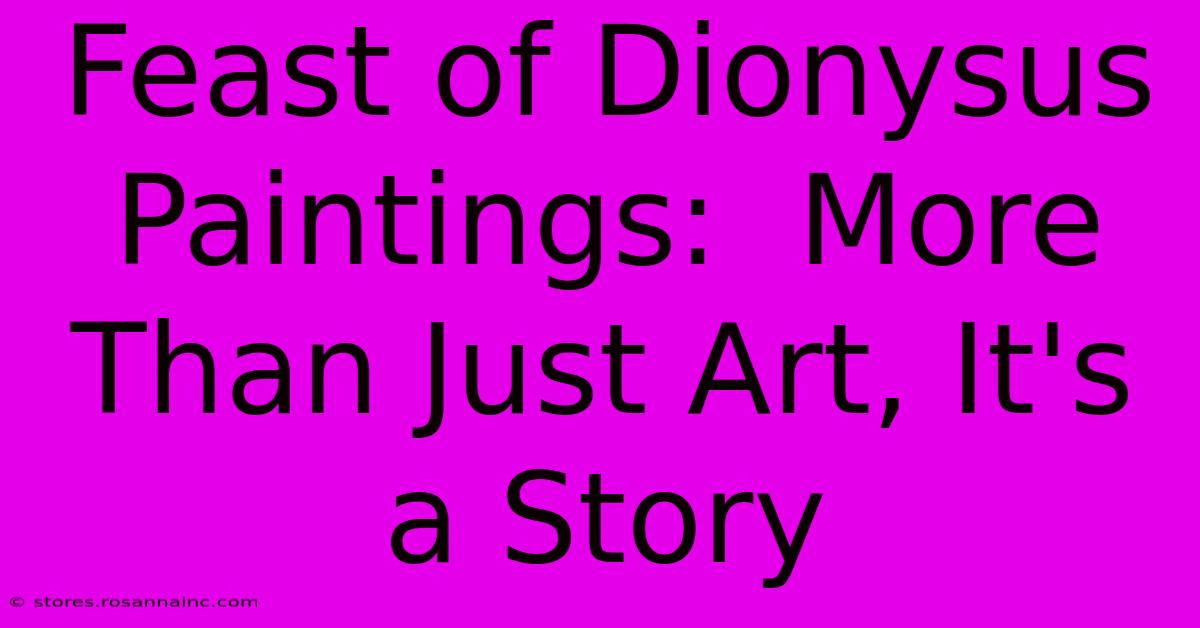Feast Of Dionysus Paintings: More Than Just Art, It's A Story

Table of Contents
Feast of Dionysus Paintings: More Than Just Art, It's a Story
The vibrant, often chaotic scenes depicted in Feast of Dionysus paintings offer far more than just aesthetic pleasure. They are rich tapestries woven with threads of mythology, social commentary, and artistic innovation. These artworks, spanning centuries and diverse artistic movements, provide a fascinating glimpse into the enduring legacy of the Greek god of wine, theatre, and fertility. Understanding these paintings requires delving beyond the surface beauty to uncover the narratives and symbolism they subtly, and sometimes overtly, convey.
Decoding the Dionysian Frenzy: Key Elements and Symbolism
Paintings depicting the Feast of Dionysus, or Dionysia, typically showcase a swirling vortex of activity. Identifying key elements helps us unravel the deeper meaning:
Dionysus Himself: The god is often central, easily identifiable by his attributes: a wreath of ivy or vine leaves, a thyrsus (a staff topped with a pine cone), and a kantharos (a drinking cup). His presence embodies the ecstatic energy and transformative power of the festival.
Satyr and Maenads: These wild, ecstatic figures are indispensable to the Dionysian narrative. Satyrs, half-human, half-goat creatures, represent untamed nature and lustful abandon. Maenads, female followers of Dionysus, are depicted in states of frenzied dancing and revelry, sometimes engaging in acts of ecstatic violence. Their presence underscores the god's ability to unleash primal instincts.
Animals: The inclusion of animals, such as lions, panthers, and bulls, further emphasizes the untamed, primal energy associated with the god. These animals often symbolize the untamed aspects of nature and the release from societal constraints experienced during the festival.
Wine and Feasting: The abundance of wine, overflowing cups, and lavish feasts are central to the visual narrative. Wine symbolizes the intoxicating power of Dionysus, blurring the lines between reality and illusion, reason and ecstasy.
Musical Instruments: Aulos (double-piped flutes), lyres, and cymbals often feature prominently. Music played a crucial role in the Dionysian rituals, further heightening the ecstatic atmosphere.
From Ancient Greece to Modern Interpretations: A Journey Through Artistic Styles
The depiction of the Feast of Dionysus has evolved significantly across artistic periods:
Ancient Greek Pottery: Early representations on vases and pottery often portray more restrained scenes, focusing on the rituals and offerings associated with the god. These images offer a valuable glimpse into the religious practices of the time.
Renaissance and Baroque: Renaissance and Baroque artists embraced the dramatic and emotional aspects of the Dionysian myth. Paintings from this period often showcase a more theatrical, visually arresting representation of the revelry, highlighting the emotional intensity and sensual abandon associated with the festival. Think of the dynamic compositions and rich color palettes employed by masters.
Modern and Contemporary Art: Modern and contemporary interpretations of the Feast of Dionysus explore new themes and perspectives. Artists may use the myth as a metaphor for liberation, creativity, or the exploration of the subconscious.
Beyond the Canvas: The Enduring Legacy of the Dionysian Feast
The enduring popularity of the Feast of Dionysus as an artistic subject underscores its continuing relevance. The themes of ecstasy, transformation, and the release from societal constraints resonate powerfully with audiences across cultures and generations. The paintings not only capture a specific historical moment but also reflect timeless human desires for freedom, celebration, and connection with the primal forces of nature. Studying these artworks allows us to engage with a rich tapestry of history, mythology, and the human condition itself. The Feast of Dionysus paintings are more than just art; they are a compelling narrative, an enduring story, painted across time.

Thank you for visiting our website wich cover about Feast Of Dionysus Paintings: More Than Just Art, It's A Story. We hope the information provided has been useful to you. Feel free to contact us if you have any questions or need further assistance. See you next time and dont miss to bookmark.
Featured Posts
-
605 Area Code Your Guide To South Dakotas Hidden Gems
Feb 10, 2025
-
Archduke Karl Ludwig The Key To Understanding Austrian History
Feb 10, 2025
-
Felipe Angeles International Airport Your Questions Answered
Feb 10, 2025
-
Where Is Area Code 223 Find Out Now
Feb 10, 2025
-
Nhl To Nfl Canucks Position Comparisons
Feb 10, 2025
